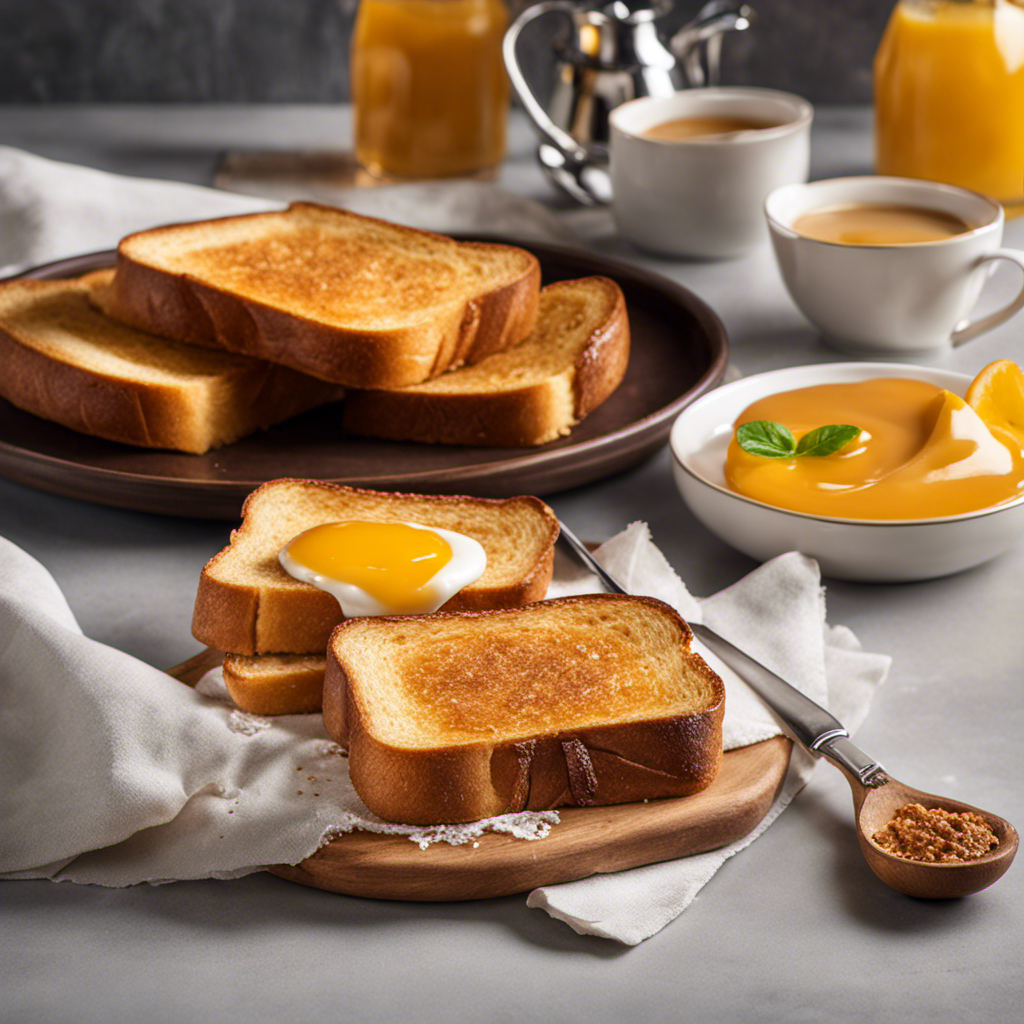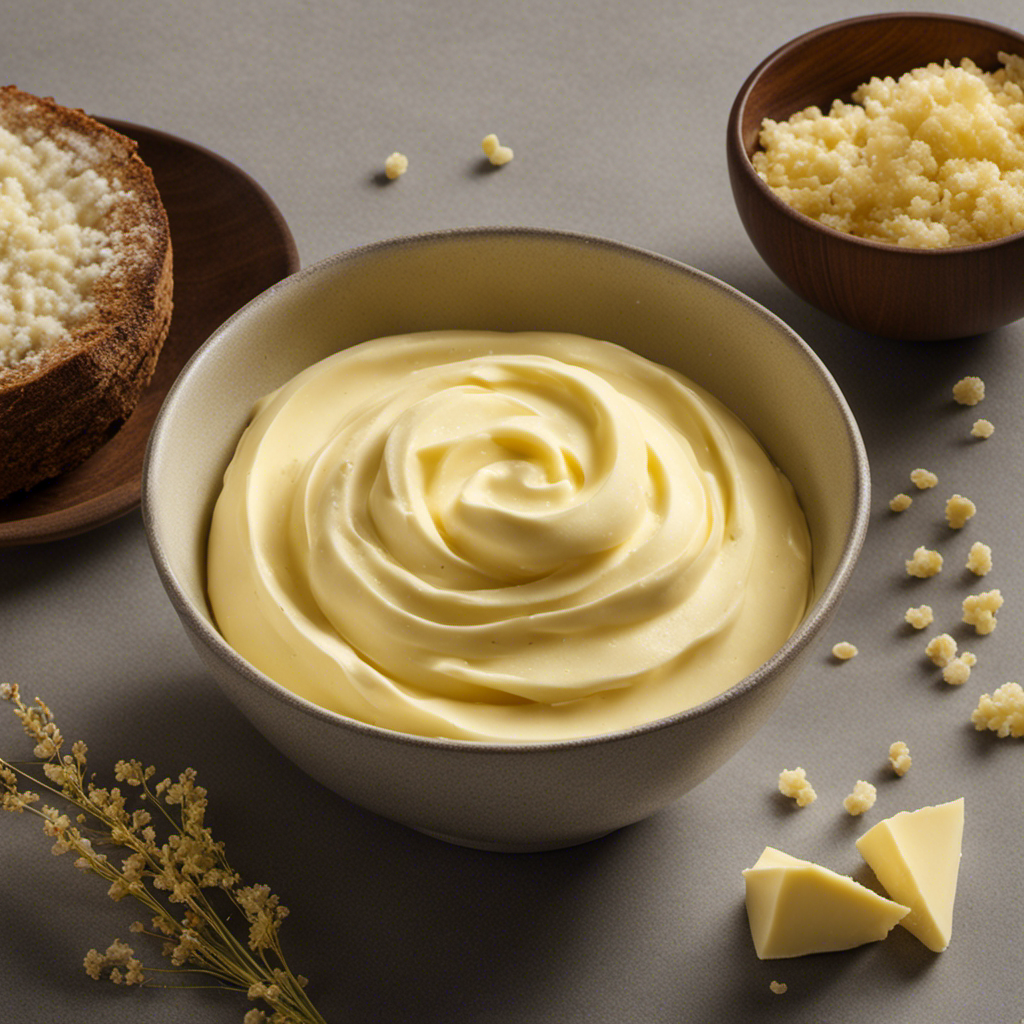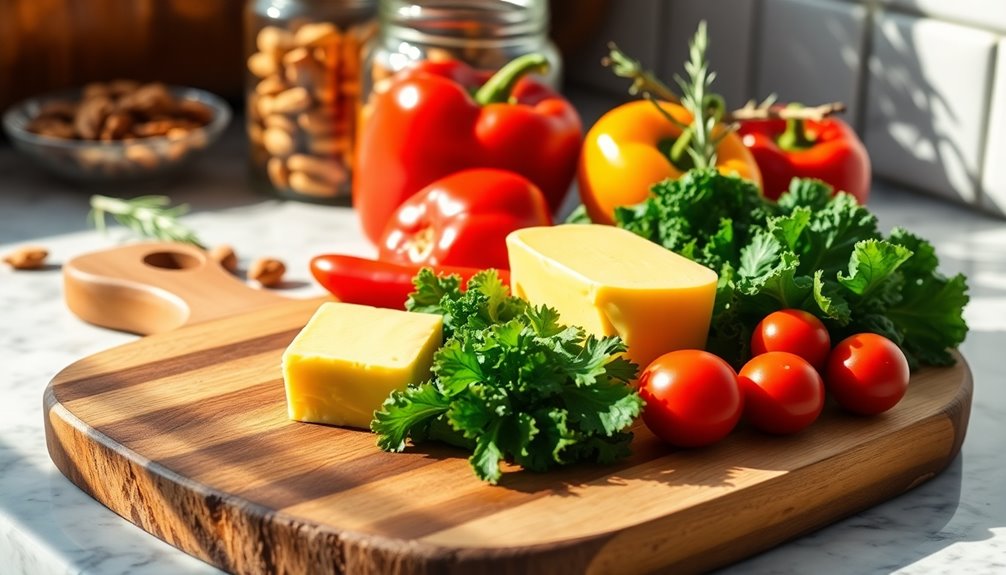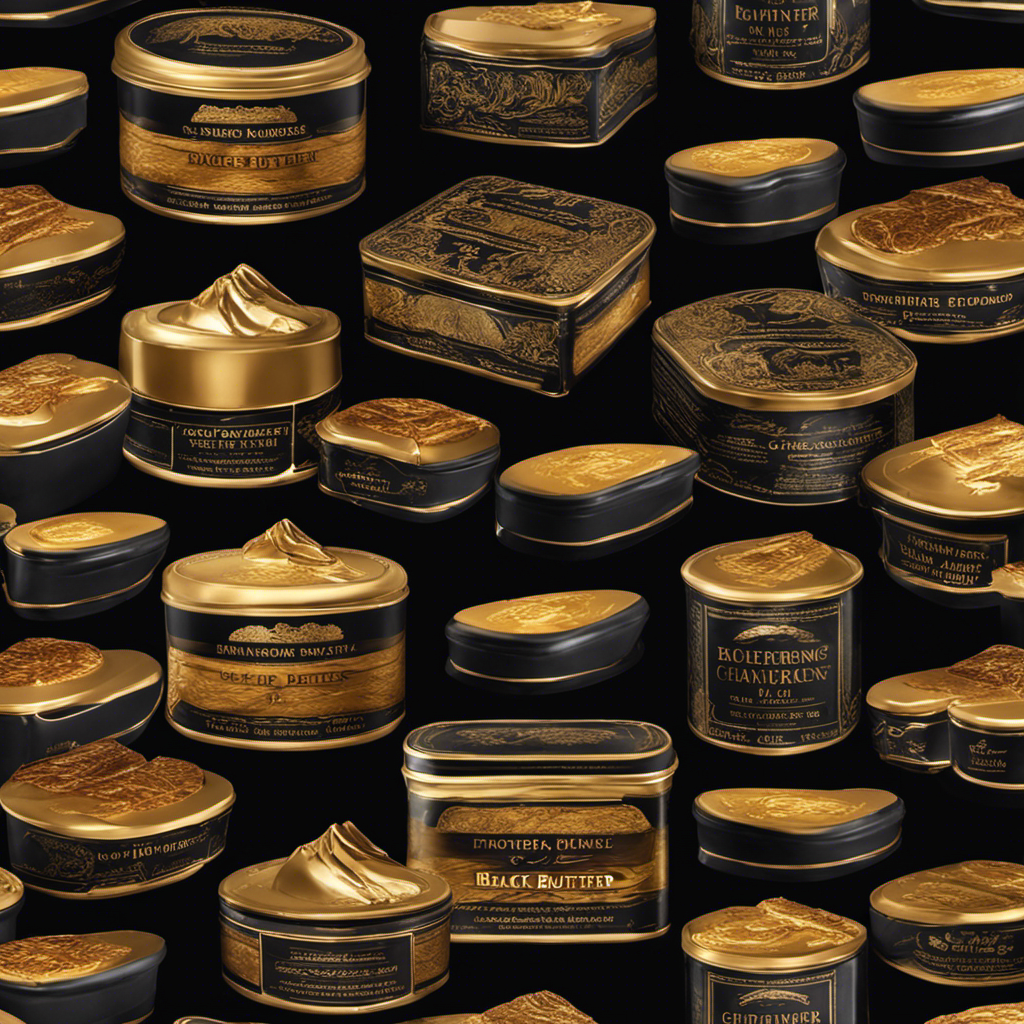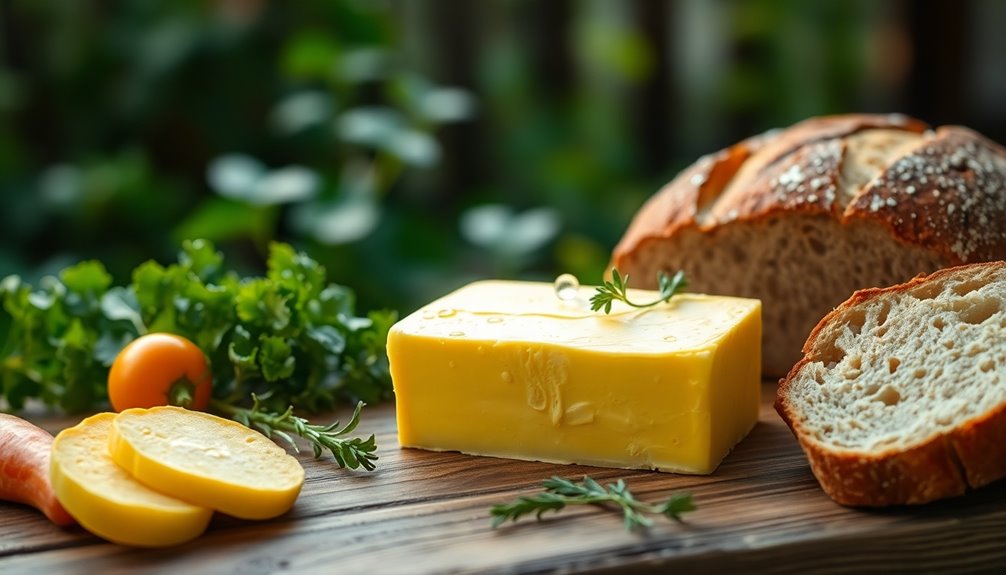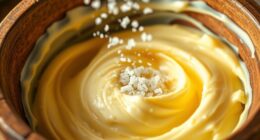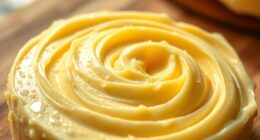It’s difficult to believe that this is not butter!
Have you ever wondered what exactly this popular spread is made of? Well, in this article, I’ll take you on a journey to uncover the history, ingredients, and nutritional information of I Can’t Believe It’s Not Butter.
We’ll also compare it to real butter and explore its uses in cooking and baking. Plus, I’ll share where you can find this butter alternative and how much it typically costs.
Get ready for some buttery knowledge!
Key Takeaways
- I Can’t Believe It’s Not Butter was first introduced in the 1980s as a healthier alternative to butter, and it has evolved over the years to meet changing consumer preferences.
- The product originated from the desire for a spread with the taste and texture of butter but with fewer calories and less fat, making it appealing to health-conscious consumers.
- The ingredients in I Can’t Believe It’s Not Butter include a blend of vegetable oils, which are low in saturated fat and high in monounsaturated and polyunsaturated fats, providing heart-healthy benefits.
- This butter substitute is widely available in most grocery stores and supermarkets, and it can also be purchased online through various retailers. Customers have praised its delicious taste, creamy texture, and versatility in recipes.
History and Origins of I Can T Believe It’s Not Butter
You might be surprised to learn that the history and origins of I Can’t Believe It’s Not Butter go back several decades. This iconic spread was first introduced in the 1980s as a healthier alternative to butter.
Over the years, it has evolved to meet the changing needs and preferences of consumers. The origin of I Can’t Believe It’s Not Butter can be traced back to the desire for a product that could provide the taste and texture of butter but with fewer calories and less fat.
The marketing and advertising strategies employed by the brand have played a significant role in its success. By emphasizing its similarity to real butter and highlighting its health benefits, the brand has managed to capture the attention of health-conscious consumers.
Now, let’s explore the ingredients in I Can’t Believe It’s Not Butter.
Ingredients in I Can T Believe It’s Not Butter
The ingredients in I Can’t Believe It’s Not Butter are carefully selected to create a delicious and spreadable alternative. This product is made with a blend of vegetable oils, including soybean oil, palm oil, and canola oil. These oils are known for their heart-healthy benefits, as they are low in saturated fat and high in monounsaturated and polyunsaturated fats. Additionally, I Can’t Believe It’s Not Butter contains water, salt, natural flavors, and Vitamin A.
Cooking tips:
- Use I Can’t Believe It’s Not Butter as a substitute for butter in your favorite recipes to reduce saturated fat intake.
- Spread it on toast, bagels, or muffins for a tasty and healthier alternative to butter.
- Melt it over steamed vegetables for a flavorful and low-fat topping.
Health benefits:
- The vegetable oils in I Can’t Believe It’s Not Butter provide essential fatty acids that support heart health.
- The low saturated fat content of this spread can help lower cholesterol levels.
- The added Vitamin A contributes to maintaining healthy skin and eyes.
Nutritional Information of I Can T Believe It’s Not Butter
Discover the nutritional information of this delicious and spreadable alternative, I Can’t Believe It’s Not Butter. This popular butter substitute offers a range of nutritional benefits while minimizing some of the health implications associated with traditional butter. Let’s take a closer look at the key nutritional facts:
| Nutrient | Amount per Serving |
|---|---|
| Calories | 70 |
| Total Fat | 8g |
| Sodium | 90mg |
| Total Carbohydrate | 0g |
I Can’t Believe It’s Not Butter is a low-calorie option, with only 70 calories per serving. It contains 8g of total fat, which is significantly lower than butter. Additionally, it has 90mg of sodium, making it a healthier choice for individuals watching their sodium intake. With 0g of total carbohydrates, it can also be suitable for those following low-carb diets. Incorporating this spread into your diet can provide a tasty alternative while offering some nutritional benefits.
How Does I Can T Believe It’s Not Butter Compare to Real Butter
Comparing I Can’t Believe It’s Not Butter to real butter, there are significant differences in terms of calorie content, total fat, sodium, and carbohydrates.
- Health Benefits of Using I Can’t Believe It’s Not Butter:
- Lower in calories compared to real butter
- Reduced total fat content
- Lower sodium content
Using I Can’t Believe It’s Not Butter as a substitute for real butter can provide several health benefits. With fewer calories, it can be a good option for those watching their weight or trying to maintain a healthy lifestyle. Additionally, it contains less total fat, which can help reduce the risk of heart disease and high cholesterol. The lower sodium content is beneficial for individuals with hypertension or those aiming to limit their sodium intake.
Overall, choosing I Can’t Believe It’s Not Butter over real butter can be a smart choice for those looking for a healthier alternative without sacrificing taste.
Cooking and Baking With I Can T Believe It’s Not Butter
I have found that cooking and baking with I Can’t Believe It’s Not Butter is a great way to enhance the versatility, flavor, and texture of my recipes. Its creamy and spreadable texture makes it easy to incorporate into a variety of dishes.
Additionally, the buttery taste of I Can’t Believe It’s Not Butter adds a rich and savory flavor to my recipes, making them even more delicious.
Lastly, I have noticed that when using I Can’t Believe It’s Not Butter in my baking, it helps to create a moist and tender texture in my cakes, cookies, and pastries.
Versatility in Recipes
Try using I Can’t Believe It’s Not Butter in a variety of recipes to see how versatile it is. I’ve personally experimented with this margarine substitute, and I’m amazed at the endless possibilities it offers in the kitchen.
Here are some ways it can enhance your cooking experience:
-
Baking: The smooth and creamy texture of I Can’t Believe It’s Not Butter makes it a perfect replacement for butter in baking. It adds moisture and richness to cakes, cookies, and pastries.
-
Sauteing: This margarine substitute has a high smoke point, making it suitable for high-heat cooking techniques like sautéing. It imparts a delicious buttery flavor to your dishes without burning.
-
Flavor combinations: I Can’t Believe It’s Not Butter is a fantastic base for creating unique flavor combinations. Pair it with herbs, spices, or citrus to elevate the taste of your dishes.
Overall, I highly recommend exploring the versatility of I Can’t Believe It’s Not Butter in your recipes.
Flavor and Texture Enhancement
When it comes to flavor improvement and texture enhancement, I Can’t Believe It’s Not Butter is a game changer. This spread is specially formulated to elevate the taste and feel of your favorite dishes. With its rich and creamy texture, it adds a luxurious mouthfeel to every bite. And the best part? It’s made with real, simple ingredients, so you can enjoy a guilt-free indulgence.
To showcase the versatility of I Can’t Believe It’s Not Butter, here’s a table highlighting some of its flavor and texture enhancing qualities:
| Ingredient | Flavor Improvement | Texture Enhancement |
|---|---|---|
| Baked goods | Adds a buttery, nutty taste | Creates a tender, moist texture |
| Pasta dishes | Enhances savory notes | Provides a smooth, velvety finish |
| Sauteed vegetables | Brings out natural flavors | Adds a luscious, silky texture |
| Grilled meats | Imparts a smoky, caramelized taste | Keeps meat juicy and succulent |
| Toast and sandwiches | Adds a savory, buttery flavor | Provides a satisfying, creamy texture |
With I Can’t Believe It’s Not Butter, you can elevate any dish and take it to the next level of deliciousness.
Where to Buy I Can T Believe It’s Not Butter and Pricing Information
When it comes to finding and purchasing I Can’t Believe It’s Not Butter, there are a few key factors to consider.
First, it’s important to know where this product is available and which stores carry it.
Additionally, exploring online purchasing options can offer convenience and accessibility.
Lastly, comparing prices with competitors can help ensure that you’re getting the best deal possible.
These three factors will be discussed in detail to provide valuable information for consumers interested in buying I Can’t Believe It’s Not Butter.
Store Availability & Locations
You can easily find I Can’t Believe It’s Not Butter at various stores near you. This popular butter substitute is widely available and can be found in most grocery stores and supermarkets. Whether you prefer to shop at big chain retailers or local mom-and-pop shops, you’ll likely be able to find this product on their shelves.
Here are some reasons why people love I Can’t Believe It’s Not Butter:
- Creamy and smooth texture that spreads easily on toast or bread.
- Deliciously buttery taste that rivals real butter.
- Versatile and can be used in cooking and baking.
Customers have given positive reviews for I Can’t Believe It’s Not Butter, praising its taste, texture, and performance in various recipes.
Online Purchasing Options
I Can’t Believe It’s Not Butter is available for purchase online through various retailers. When considering buying a product online, it’s always a good idea to check out the online reviews and customer testimonials. These can provide valuable insights into the quality and performance of the product.
Fortunately, I Can’t Believe It’s Not Butter has received positive feedback from many customers. Online reviews often highlight the creamy texture, delicious taste, and versatility of this butter substitute. Customers have praised its ability to spread smoothly on toast and melt perfectly on vegetables. Some have even compared it to the real thing!
Price Comparison With Competitors
If you’re looking to compare prices with competitors, it’s worth checking out other butter substitute brands to see if you can find a better deal. When it comes to price comparison, customer reviews can be a valuable resource.
Here are a few emotional responses that customers have shared through their reviews:
-
Some customers were pleasantly surprised by the affordable prices of certain butter substitute brands. They felt relieved to find a budget-friendly option that didn’t compromise on taste or quality.
-
Others expressed frustration at the high prices of certain brands, feeling like they were being taken advantage of. They longed for more affordable alternatives that still provided a delicious buttery flavor.
-
A few customers shared their excitement when they discovered a brand that not only had a competitive price but also surpassed their expectations in terms of taste and texture. They felt like they had struck gold.
Frequently Asked Questions
Is I Can’t Believe It’s Not Butter Suitable for Vegans?
I’m not sure if I Can’t Believe It’s Not Butter is suitable for vegans. However, there are vegan alternatives to this spread that you can explore. Additionally, it may have certain health benefits, but further research is needed.
Does I Can’t Believe It’s Not Butter Contain Any Artificial Preservatives?
Yes, I Can’t Believe It’s Not Butter does not contain any artificial preservatives. This makes it a healthier choice compared to other butter substitutes that may have additives that are not good for our health.
Can I Use I Can’t Believe It’s Not Butter for Frying?
Yes, I can use "I Can’t Believe It’s Not Butter" for frying. It is a vegan butter alternative that does not contain any artificial preservatives. Using plant-based spreads can have health benefits.
How Does I Can’t Believe It’s Not Butter Taste Compared to Real Butter?
I can’t believe it’s not butter is a margarine alternative. Compared to real butter, it has a similar taste but a lighter texture. It’s a good option for those looking to reduce their saturated fat intake.
Is I Can’t Believe It’s Not Butter Gluten-Free?
I’m not sure what "I Can’t Believe It’s Not Butter" is, but if you’re asking if it’s safe for people with celiac disease and if it can be used as a substitute in gluten-free recipes, I can look it up for you.
Conclusion
After learning about the history, ingredients, and nutritional information of I Can’t Believe It’s Not Butter, it is clear that this butter alternative offers a healthier option for those looking to reduce their intake of saturated fats.
With its smooth texture and delicious taste, it is a versatile ingredient for cooking and baking. Whether you’re spreading it on toast or using it in a recipe, this product is easily accessible and reasonably priced.
So why not give I Can’t Believe It’s Not Butter a try and see for yourself why it’s a popular choice among health-conscious individuals?
